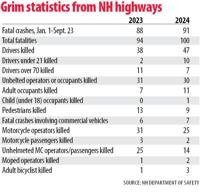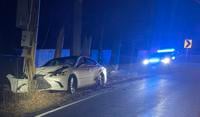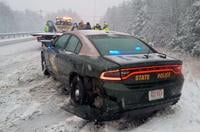As a driver’s-education teacher and former police officer, Scott Rogers is worried that young drivers don’t understand the risks they take.
New Hampshire has seen a 400% increase in drivers under 21 dying in crashes from this time last year, Department of Safety officials said. So far, 10 young drivers have been killed in 2024, compared with two in the same period in 2023.
“It’s very disturbing,” said Rogers, owner of Thin Blue Line Driving School in Windham, Londonderry and Meredith. “And 94% of crashes that are occurring are human error.”
Fifty people died in crashes from June to August this year, including 16 people on motorcycles. This year, there have been nearly 100 crash deaths, an increase of 7% over the same period last year. After a spike of deadly crashes earlier in the summer, motorcycle fatalities are now 18% lower than at this time in 2023, according to state statistics.
According to AAA, the period from Memorial Day to Labor Day is known as the “100 Deadliest Days for Teen Drivers.” Nearly half of teen driving deaths occur during the summer months.
“Traffic crashes are the leading cause of death for teens ages 16-19,” said Daniel Goodman, a spokesman for AAA in New Hampshire. “For every mile driven, new teen drivers (ages 16-17) are three times more likely to be involved in a deadly crash compared to adults. “
State Police Lt. Chris Storm said he sees dangerous behaviors across all age groups on state highways.
“It’s always the same thing — people are driving too fast for the conditions, they’re distracted or they’re impaired,” Storm said. “Unfortunately, we continue to see those trends going up.”


‘Just be respectful’
Storm and Rogers said they’ve observed increased aggression among drivers since the COVID-19 pandemic — people are less respectful and more distracted than ever, and speeds are way up. Deadly teen crashes have increased 10% since pre-pandemic 2019, AAA reported.
“We’ve been seeing a massive uptick in both speeding and aggressive driving” since COVID, Storm said.
“People are more aggressive,” Rogers said. “They’re driving faster, not using directionals. The things we’re seeing in the driver’s-ed car are crazy. We get passed on the right, passed on the left, on a double-yellow line. People don’t care.”
State Police have stepped up their tactics to address speeding and impaired driving, setting up high-visibility enforcement zones, using aircraft to nab speeders and increasing patrols and checkpoints.
Still, deadly crashes and arrests for excessive speeds piled up this summer. Whether it’s four people killed last weekend or someone accused of going 125 mph while under the influence, police say they have their hands full. Especially with distracted driving.
Newer cars are bigger, lighter and faster; block out road noise better; and have more technology that connects their entertainment systems to drivers’ phones — all of which leads to drivers feeling less connected to the traffic around them and decreases their response time, Storm said.
Nearly 60% of drivers admit to risky driving behaviors such as speeding, distracted driving, and aggressive driving, according to a new report by the AAA Foundation for Traffic Safety.
Inexperience
Rogers said he’s seen things get worse over his 30 years as a police officer and since becoming a driving instructor after he retired 13 years ago.
“I dealt with teen fatalities while I was on the job. I had to arrest teens for making poor decisions behind the wheel,” Rogers said. “Teens are in the highest category of crashes because they lack experience.”
Two of his former students are among the 10 teens killed in fatal crashes this year. One of those kids was not wearing a seatbelt and was ejected. The car landed on him and crushed him.
Teens just aren’t locked in, Rogers said, especially if there are other teens in the car.
“They’ve got to do the little things right to avoid the big thing going wrong — signal, mirrors, anticipation, look over their shoulder, aim high with your eyes into the intended path of travel,” he said.
Another trend he sees is many teens are not coming into driver’s education with enough hours behind the wheel with their parents.
“In one class recently, I had four teens come in with zero hours,” Rogers said. “There’s just not the commitment on both ends — teens not motivated, the parents aren’t pushing them.
“There is fudging going on, let’s be honest. I’ve heard that. The parents just want their kids to get the license, so they sign off, saying they did the 30 and 10 hours — 30 hours daytime, 10 nighttime.”
Penalties
Rogers said 60% of teen drivers will have a crash, get a ticket or be arrested in their first year of driving.
Two weeks ago, a teenager cut off a motorcyclist in Exeter and the biker was killed. The teen was cited for failure to yield. Now that girl has to live with that the rest of her life, he said.
Rogers wonders if young drivers understand the potential consequences of their actions and inactions — which also extends to not wearing seatbelts or using their phones hands-free.
“Tickets aren’t a deterrent,” Rogers said.
He suggested the drivers should be assessed points for hands-free violations, which would put their driving privileges in jeopardy.
“Why isn’t more taking place at the state level with reps and senators and the New Hampshire Office of Highway Safety?” Rogers asked.
State Police Col. Mark Hall said officials are analyzing the data and trends, and are awaiting the completion of investigations and toxicology reports to gain “a more comprehensive understanding” of the rise in traffic deaths.
“We aim to identify key patterns and insights that will inform targeted strategies and interventions to enhance road safety and reduce the occurrence of such tragic events,” Hall said in an email.















